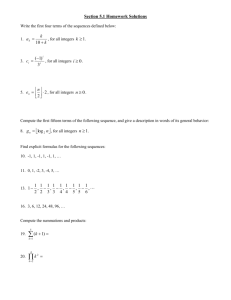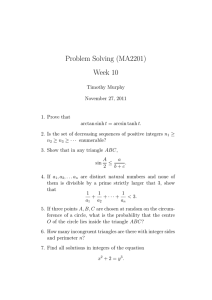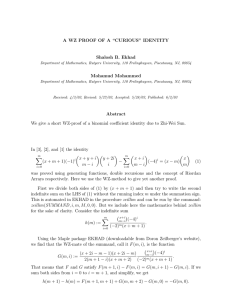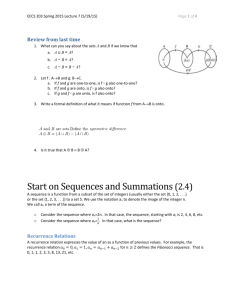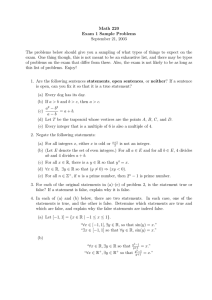AN INVARIANT SUM RELATED TO RECORD STATISTICS Tam´ as Lengyel
advertisement
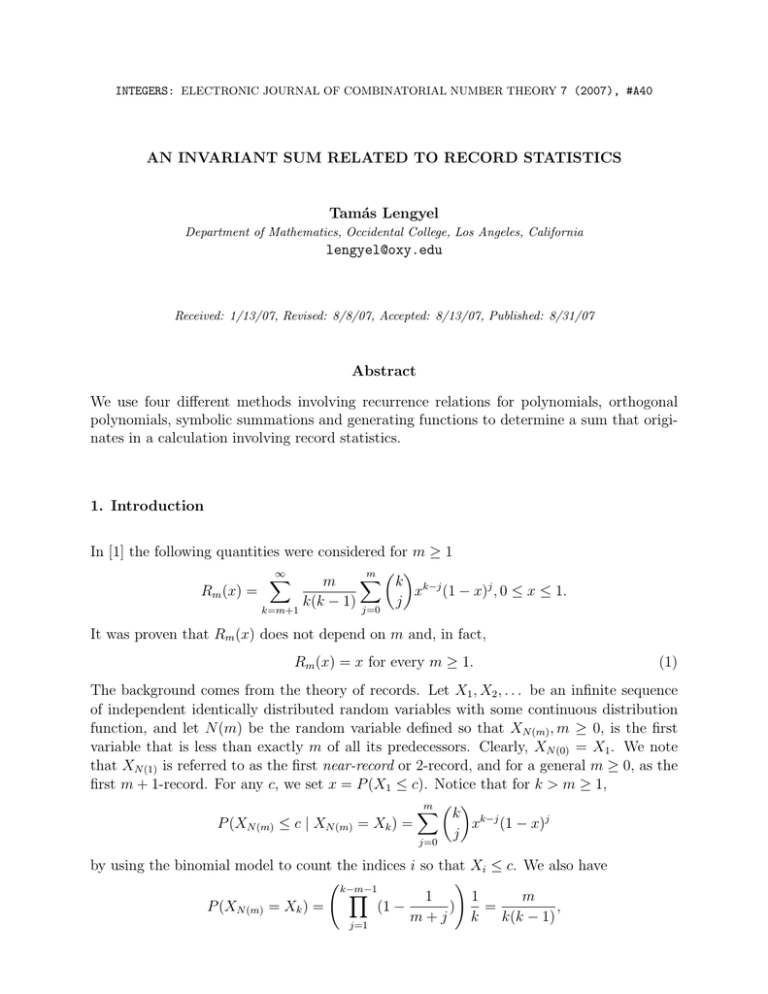
INTEGERS: ELECTRONIC JOURNAL OF COMBINATORIAL NUMBER THEORY 7 (2007), #A40
AN INVARIANT SUM RELATED TO RECORD STATISTICS
Tamás Lengyel
Department of Mathematics, Occidental College, Los Angeles, California
lengyel@oxy.edu
Received: 1/13/07, Revised: 8/8/07, Accepted: 8/13/07, Published: 8/31/07
Abstract
We use four different methods involving recurrence relations for polynomials, orthogonal
polynomials, symbolic summations and generating functions to determine a sum that originates in a calculation involving record statistics.
1. Introduction
In [1] the following quantities were considered for m ≥ 1
∞
m " #
!
!
m
k k−j
Rm (x) =
x (1 − x)j , 0 ≤ x ≤ 1.
k(k
−
1)
j
j=0
k=m+1
It was proven that Rm (x) does not depend on m and, in fact,
Rm (x) = x for every m ≥ 1.
(1)
The background comes from the theory of records. Let X1 , X2 , . . . be an infinite sequence
of independent identically distributed random variables with some continuous distribution
function, and let N (m) be the random variable defined so that XN (m) , m ≥ 0, is the first
variable that is less than exactly m of all its predecessors. Clearly, XN (0) = X1 . We note
that XN (1) is referred to as the first near-record or 2-record, and for a general m ≥ 0, as the
first m + 1-record. For any c, we set x = P (X1 ≤ c). Notice that for k > m ≥ 1,
m " #
!
k k−j
P (XN (m) ≤ c | XN (m) = Xk ) =
x (1 − x)j
j
j=0
by using the binomial model to count the indices i so that Xi ≤ c. We also have
$k−m−1
&
%
1
1
m
P (XN (m) = Xk ) =
(1 −
)
=
,
m
+
j
k
k(k
−
1)
j=1
INTEGERS: ELECTRONIC JOURNAL OF COMBINATORIAL NUMBER THEORY (2007), #A40
2
since the probability that Xk is less than exactly m of its predecessors is 1/k, [1]. It follows
that P (XN (m) ≤ c) = Rm (x) = x, and perhaps surprisingly, XN (m) and Xi , i ≥ 1, have the
same distribution. (Of course, XN (0) = X1 , so the statement is true for all first m+1-records,
m ≥ 0.) In fact, more can be said as XN (m) , m = 0, 1, 2, . . . , are independent and identically
distributed random variables and even the sets of m + 1-records, formed by the m + 1-records
in the sequence Xi , i = 1, 2, . . . , are independent and identically distributed random sets (cf.
[3]).
After some experimentation we noticed that the sum Rm (x) could be generalized. Here
we extend identity (1) for the modified sum, am,n (x), given any integers m and n with
0 ≤ n − 1 ≤ m, and set
"
# !
∞
m " #
m
1 ! k k−j
'k (
am,n (x) =
x (1 − x)j .
(2)
n − 1 k=m+1 n j=0 j
Often, for notational convenience, we will simply leave out the argument x and write, for
example, am,n instead of am,n (x). We prove that am,n (x) does not depend on m if m ≥ n − 1.
Theorem 1. For integers n > 0 and m ≥ n − 1, we have
)
'
(
n
1 − (1 − x)n−1 , if n ≥ 2 and 0 ≤ x ≤ 1
n−1
am,n (x) =
− ln(1 − x),
if n = 1 and 0 ≤ x < 1.
Remark. Note that Rm (x) = am,2 (x)/2 = x by [1].
In Section 2, we present a recurrence based proof. Section 3 offers an alternative proof
via differentiation. Section 4 is devoted mainly to a proof of the theorem by symbolic summations provided by the Mathematica package MultiSum [9], with alternative summation
methods mentioned including the more traditional approaches based on the manipulation of
binomial sums and hypergeometric series. The last section is based on the use of generating
functions. We note that the methods presented or mentioned in Sections 3, 4.3, and 5 do
not require the a priori knowledge of the suggested closed form of am,n (x).
2. Proof by Recurrence Relations
We will eventually need a basic fact. It is well known that for n ≥ 2
! 1
n
'k ( =
.
n
−
1
k≥n n
(In fact, it is a WZ companion identity of the Vandermonde identity [7].) We can easily
generalize this and obtain
INTEGERS: ELECTRONIC JOURNAL OF COMBINATORIAL NUMBER THEORY (2007), #A40
3
Lemma 2. For any integer T with 2 ≤ n ≤ T , we have
" #!
T
1
T
'k ( =
.
n k≥T n
n−1
Proof. By using hypergeometric series, it is easy to see that
! 1
1
1 T
'k ( = 'T ( 2 F1 (T − n + 1, 1; T + 1; 1) = 'T (
n−1
n
n
k≥T n
by Gauss’ identity as n ≥ 2.
!
Proof of Theorem 1. In fact, by accounting for the changes in (2) as we move from am−1,n
to am,n , we get the recurrence
n
+ m−n+1
(1 − x)n−1
'
(
m
n
= m−n+1
am−1,n − m−n+1
1 − (1 − x)n−1
am,n =
m
a
m−n+1 m−1,n
−
n
m−n+1
(3)
for m > n − 1 ≥ 0. The second term on the right-hand side of the first identity removes the
extra terms with k = m, and the third term adds the new terms due to j = m.
The *
case n = 1 follows immediately. First observe that if m = n − 1 = 0 then we have
xk
a0,1 = ∞
k=1 k = − ln(1 − x) by (2), and for n = 1, equation (3) implies that am,1 = am−1,1
for all m ≥ 1.
A similar direct use of (3) fails for n ≥ 2 since we do not readily have the proof of Theorem 1
for any particular am,n (x), m ≥ n − 1. (The case n = 2 is proven in [1] but here we look for
a self contained proof.) If n ≥ 2 then we set
(
n '
bm,n (x) = am,n (x) −
1 − (1 − x)n−1
(4)
n−1
and prove that
bm,n =
"
#
m
bn−1,n .
n−1
To see this, we observe that (3) can be rewritten as
+
'
(
'
(,
n
m
n
bm,n + n−1
1 − (1 − x)n−1 = m−n+1
bm−1,n + n−1
1 − (1 − x)n−1
'
(
n
− m−n+1
1 − (1 − x)n−1
which can be simplified to
bm,n =
m
bm−1,n ,
m−n+1
(5)
INTEGERS: ELECTRONIC JOURNAL OF COMBINATORIAL NUMBER THEORY (2007), #A40
4
and thus implies equation (5). Now we use an argument on the asymptotic order of magnimn−1
tude of bm,n . If m → ∞ then bm,n ∼ (n−1)!
bn−1,n , and thus either bm,n = 0 for all m ≥ n − 1
or bm,n → ∞.
We will see that the former case applies here. In view of the equation (2), for all x with
0 ≤ x ≤ 1 we have
,-- ' ( *
'
∞
m
n
1
n
|bm,n (x)| = -- am,n (x) − n−1
1 − (1 − x)n−1 -- ≤ n−1
k=m+1 ( k ) + n−1
n
'm+1( *∞
n
1
n
n m+1
n
2n
= m+1
k=m+1 ( k ) + n−1 = m+1 n−1 + n−1 ≤ n−1
n
n
by Lemma 2. This prevents bm,n (x) from growing indefinitely
Since
bm,n (x) is
' as m → ∞.
(
n
zero if 1 ≤ n − 1 ≤ m and 0 ≤ x ≤ 1, we have am,n (x) = n−1
1 − (1 − x)n−1 .
!
3. Proof by Differentiation
Proof of Theorem 1. The statement of Theorem 1 is true for x = 0, as we get am,n (0) = 0,
and it is also true if n ≥ 2 and x = 1, since
"
# !
∞
m
1
n
'k ( =
am,n (1) =
n − 1 k=m+1 n
n−1
by Lemma 2.
We assume that 0 ≤ x < 1 in the remainder of this paper.
Inspired by the fact that Ln (x) = 1 − (1 − x)n , n ≥ 1, satisfies the familiar recurrence
x L$n (x) = n Ln (x) − n Ln−1 (x)
for the Laguerre polynomials (although here L1 (x) = x rather than 1 − x), we take the
derivative of am,n (x) in hopes of finding some recurrence relation that does not contain m
anymore. Indeed, the derivative of am,n (x), 0 ≤ n − 1 ≤ m, is n(1 − x)n−2 since
+* ' (
,
' m ( *∞
*m 'k−1( k−j
m
k−1
k
k−1−j
j
j−1
a$m,n (x) = n−1
x
(1
−
x)
−
x
(1
−
x)
k=m+1 ( k )
j=0
j=1 j−1
j
n
' m ( *∞ (mk ) k−m
= n n−1
(1 − x)m
k=m ( k ) x
n−1
= n(1 − x)m 2 F1 (1, m − n + 2; 1; x) = n(1 − x)n−2 ,
by a standard hypergeometric identity. This implies Theorem 1.
We note that this seems to be the shortest way to prove Theorem 1.
!
INTEGERS: ELECTRONIC JOURNAL OF COMBINATORIAL NUMBER THEORY (2007), #A40
5
4. Proof by Symbolic Summations
As in Section 2, we find a recurrence relation for am,n (x) but this time without any “manual
effort.” After checking the initial cases with n = 1 and 2, we prove the statement inductively
for n ≥ 3.
Here is the sketch of the steps. The Mathematica program package MultiSum uses the
notation SUM[m, n] = am,n (x). As above, we assume that m ≥ n − 1 ≥ 0. We rewrite
the summand in (2) in proper hypergeometric terms [9, Definition 2.1] below. We face a
summation with nonstandard boundary conditions [9, Sections 2.7.3 and 3.4; and Chapter 5]
such as k ≥ m + 1 and j ≤ m. We are able to transform this problem into one with standard
boundary conditions with the help of the so called “limit argument.” In fact, the role of the
extra parameter ε in (6) is that the summand vanishes as ε → 0 for all indices outside the
summation region (and the condition j ≥ 0 is taken care of by the denominator without the
limit argument).
4.1. General Case
We execute the following four Mathematica commands.
j
−j+k
x
(−1+ε+k−m)! m! (ε−j+m)! (k−n)!
FindRecurrence[ n (1−x)
,
j! (−j+k)! (−1+k−m)! (−j+m)! (1+m−n)!
(6)
{m, n}, {0, 0}, {k, j}, {0, 2}]
(%//SumCertificate)/. ε → 0
Solve[%, SUM[2 + m, 2 + n]]
ShiftRecurrence[%, {m, −2}, {n, −1}]
We obtain that
SUM[m, 1 + n] →
1+n
(−1+n)n2
'
(−1 + m) n (−1 + x) SUM[−2 + m, −1 + n]
− (1 + m − n) n (−1 + x) SUM[−1 + m, −1 + n]
− (−1 + n) (1 − m − n − x + nx) SUM[−1 + m, n]
(
+ (−1 + n) (−1 − m + n) SUM[m, n]
(7)
INTEGERS: ELECTRONIC JOURNAL OF COMBINATORIAL NUMBER THEORY (2007), #A40
6
The case of SUM[m, 3] follows immediately if we substitute SUM[ , n ] by f [n] defined as
(
n '
f [n ] := If[n == 1, −Log[1 − x],
1 − (1 − x)n−1 ]
n−1
For SUM[m, n + 1] with n ≥ 3, we can proceed by the substitution
'
(
n 1 − (1 − x)−1+n
%/.SUM[ , n ] →
−1 + n
in (7). In fact, after simplification we get that SUM[m, n + 1] is equal to
(1 + n) (−1 + (1 − x)n )
−
.
n
!
4.2. Initial Cases
We are left with checking the initial cases n = 1 and 2. Can we derive these initial cases
within the framework of symbolic summation?
In fact, we can. We extend the range of summation for k in the definition (8) to simplify the
structure of summation and find a recurrence. The difference between cm,n (x) and am,n (x)
can be easily calculated, without any symbolic manipulation, as it will become apparent in
identity (10). We set
"
#!
∞
m " #
m
1 ! k k−j
' (
cm,n (x) =
x (1 − x)j ,
(8)
n − 1 k=n nk j=0 j
with cn−1,n (x) = an−1,n (x).
j
The MultiSum commands FindRecurrence[ (1−x)
j
x−j+k
x−j+k (−1+ε+k)! (ε−j+m)!
, m, {k, j}]
j! (−j+k)! (−j+m)!
and
(−2+ε+k)! m! (ε−j+m)!
FindRecurrence[ 2 (1−x)
, m, {k, j}], for n = 1 and n = 2, respectively
j! (−j+k)! (−1+m)! (−j+m)!
find the following recurrences for cm,1 (x) and cm,2 (x) in the single variable m
)
1
((1 − m)SUM[−2 + m] + (−1 + 2m)SUM[−1 + m]) , if n = 1 and m ≥ 2;
m
SUM[m] =
−SUM[−2 + m] + 2SUM[−1 + m],
if n = 2 and m ≥ 3,
(9)
with the notation SUM[m] = cm,n (x).
We set
gm,n (x) = cm,n (x) − am,n (x) =
=
'
( *m
m
n−1
)*
m
k=n
1
k
n
()
1
i=1 i ,
''
(
m
n
n−1
n−1
*m 'k( i−j
(1 − x)j
j=0 j x
if n = 1;
(
− 1 , if n ≥ 2,
(10)
INTEGERS: ELECTRONIC JOURNAL OF COMBINATORIAL NUMBER THEORY (2007), #A40
7
* 'k( i−j
by Lemma 2 since m
(1−x)j = 1 as k ≤ m. We note that gm,1 is the mth harmonic
j=0 j x
number while gm,2 = 2(m − 1), and in general, gm,n is a constant polynomial, so we can drop
its argument.
It is easy to check that c0,1 (x) = −Log[1 − x] and c1,1 (x) = −Log[1 − x] + 1, and in general,
cm,1 = −Log[1 − x] + gm,1 , m ≥ 0, satisfies (9). Similarly, c1,2 (x) = 2x and c2,2 (x) = 2x + 2,
and cm,2 = 2x + gm,2 , m ≥ 1, satisfies (9). Now it follows that am,1 (x) = −Log[1 − x] and
am,2 (x) = 2x.
!
4.3. Other Options for Symbolic Summation
Paule [5] obtained another “automatic” proof of Theorem 1 using only single summations
and the RISC implementation of the Gosper’s and Zeilberger’s algorithms.
Of course in hindsight, hand calculations can replace the symbolic techniques, if one knows
the lucky sequence of manipulations in advance. We try to avoid these calculations although
we note that they can be accomplished by repeated and somewhat dull applications of
identities for binomial summations [2, identities (5.24) and (5.25) on p. 169] Another nonautomatic option is to use the HYP package for handling hypergeometric series and identities
in a systematic way, e.g., by repeatedly applying the Chu-Vandermonde identity, cf. [4].
Paule [5] and Schneider [8] also obtained recurrence relations for the truncated sum
a(K)
m,n
=
"
# !
K
m " #
m
1 ! k k−j
' (
x (1 − x)j
n − 1 k=m+1 nk j=0 j
using the package Sigma, cf. [6]. We took another approach as we
sum
*need the modified
m
cm,n (x) in order to determine am,n (x) via the generating function ∞
c
(x)t
in
the
m=n−1 m,n
next section.
5. Proof by Generating Function
Finally, we use the generating function of the polynomials cm,n (x) defined in (8). More
precisely, we define
∞
!
C(x, t, n) =
cm,n (x)tm
m=n−1
for −1 < t < 1 which will guarantee the absolute convergence of our sums for 0 ≤ x < 1.
A similar generating function, in the context of DNA matching, was discussed
by us( k−j
*m in'k[10]
ing the method of characteristics. In fact, with the notation Qm (x, k) = 1− j=0 j x (1−
INTEGERS: ELECTRONIC JOURNAL OF COMBINATORIAL NUMBER THEORY (2007), #A40
8
x)j , m = 0, 1, . . . , Wilf found that
∞
!
1 − (1 − (1 − t)(1 − x))k
Qm (x, k)t =
.
1−t
m=0
Below we will need
m
∞
!
(1 − (1 − t)(1 − x))k
f (x, t, k) =
(1 − Qm (x, k))t =
,
1−t
m=0
which implies that
m
"
#
∞
!
1
∂ n−1
m
f (x, t, k) =
(1 − Qm (x, k))tm−(n−1) .
n−1
(n − 1)! ∂t
n−1
m=n−1
(11)
On the other hand,
,
*k 'k(
i−1
i
(1
−
t)
(x
−
1)
i=1 i
+
(i ,
*k 'k(' i−1 ('
1
n−1
= (1−t)
(n
−
1)!
+
(−1)
(n
−
1)!
(1
−
t)(x
−
1)
.
n
i=n i n−1
(12)
By changing the order of summation below, we derive that
+' ( *
,
*∞
*m 'k( k−j
∞
m
1
j
C(x, t, n) = m=n−1 n−1
(1 − x) tm
k=n ( k )
j=0 j x
n
' m ( *∞ 1
*∞
m
= m=n−1 n−1
k=n ( k ) (1 − Qm (x, k))t
n
(13)
'm(
*∞ 1 *∞
m
= k=n k
(1 − Qm (x, k))t
(n) m=n−1 n−1
*∞ 1 ∂ n−1
tn−1
= (n−1)!
k=n ( k ) ∂tn−1 f (x, t, k)
n
k
∂ n−1 (1+(1−t)(x−1))
∂ n−1
= ∂t
n−1
∂tn−1
1−t
+
1
1−t
+
by (11). Observe that if n = 1 then
C(x, t, 1) =
∞
!
(1 − (1 − t)(1 − x))k
k(1 − t)
k=1
$
&
∞
m
!
ln ((1 − t)(1 − x)) !
1 m
=−
=
−ln(1 − x) +
t ,
1−t
i
m=0
i=1
and we are done according to (10).
From now on we assume that n ≥ 2. By another change in the order of summation, we
tn−1
can rewrite the last sum in (13) by (12), without the first term (1−t)
n , and we get
*∞
k=n
1
k
n
()
+*
k
'k(' i−1 ('
(i ,
(i
*∞ *k (ki)(ni ) ni '
(1
−
t)(x
−
1)
=
(1 − t)(x − 1)
k
i=n i n−1
k=n
i=n
(n)
'
(i
*∞ *k n (nk )(k−n
i−n )
= k=n i=n i
(1 − t)(x − 1)
k
(n)
(i
*∞ *k 1 'k−n('
= n k=n i=n i i−n (1 − t)(x − 1) .
(14)
INTEGERS: ELECTRONIC JOURNAL OF COMBINATORIAL NUMBER THEORY (2007), #A40
9
To evaluate the last expression, we set
hk (a) =
#
k "
!
k−n 1
i=n
i−n
i
ai .
Observe that we have
h$k (a)
n−1
=a
#
k "
!
k − n i−n
a
= an−1 (1 + a)k−n ,
i
−
n
i=n
and thus, for −2 < a < 0,
∞
!
k=n
h$k (a) = an−1
1
= −an−2 .
1 − (1 + a)
The
for a = 0. Clearly, hk (0) = 0 for k ≥ n; thus, we can rewrite (14) as
*∞result also holds
n
n k=n hk (a) = − n−1 an−1 by integration.
As −1 < t < 1 and 0 ≤ x < 1, for a = (1 − t)(x − 1) we have −2 < a < 0. Putting back
the first term and using Lemma 2, we obtain that
n
tn−1 '
n
tn−1
n tn−1 (1 − x)n−1
n−1 (
1
−
((1
−
t)(1
−
x))
=
−
.
n − 1 (1 − t)n
n − 1 (1 − t)n n − 1
1−t
'' m (
(
n
By expanding this according to the powers of t, we get that cm,n (x) = n−1
−1 +
n−1
n
(1 − (1 − x)n−1 ) = gm,n (x) + am,n (x), for m ≥ n − 1, and simply apply (10).
!
n−1
C(x, t, n) =
Acknowledgments. I wish to thank Peter Paule and Carsten Schneider for sharing their
results regarding the original and the truncated sums, Gregory Tollisen and the referee for
careful reading of the manuscript and suggestions.
References
[1] G. Blom, Problem 6522, Amer. Math. Monthly 93:485, Solution by Isreal, R. B., Persistence of a
distribution, in 95 (1988), 360-362, 1986.
[2] Ronald L. Graham, Donald E. Knuth, and Oren Patashnik, Concrete Mathematics, Addison-Wesley
Publishing Company, Reading, MA, 1994.
[3] Z. Ignatov, Point processes generated by order statistics and their applications, in Point Processes and
Queuing Problems (Colloq., Keszthely, 1978), vol. 24 of Colloq. Math. Soc. János Bolyai, 109-116, NorthHolland, Amsterdam, 1981.
[4] C. Krattenthaler, personal communication, 2006.
http://www.mat.univie.ac.at/∼kratt/hyp hypq/hyp.html.
The
software
is
available
at
INTEGERS: ELECTRONIC JOURNAL OF COMBINATORIAL NUMBER THEORY (2007), #A40
10
[5]
P.
Paule,
personal
communication,
2006.
The
http://www.risc.uni-linz.ac.at/research/combinat/software.
at
software
is
available
[6] P. Paule and C. Schneider, Truncating binomial series with symbolic summation, manuscript, 2006.
[7] M. Petkovsek, H. S. Wilf, and D. Zeilberger, A=B, A. K. Peters, Wellesley, MA, 1996.
[8] C. Schneider, personal communication, 2006.
The
http://www.risc.uni-linz.ac.at/research/combinat/software.
software
will
be
available
at
[9] K. Wegschaider, Computer generated proofs of binomial multi-sum Kepler University, May
1997. It is available at http://apache.risc.uni-linz.ac.at/internals/ActivityDB/publications/
download/risc 2245/diplom.ps.
The software is available at http://www.risc.uni-linz.ac.at/
research/combinat/software/MultiSum.
[10] H. S. Wilf, The method of characteristics, and ‘problem 89’ of Graham, Knuth, and Patashnik, available
at http://www.math.upenn.edu/∼wilf/website/GKPProblem89.pdf, 2005.
